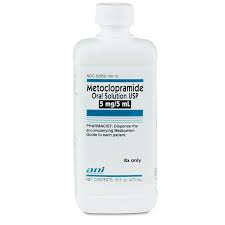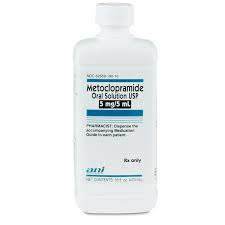Providing Quality & Trust || Clinic Website
Detailed Description
Metoclopramide
(met-oh-kloe-pra-mide)
- Description: Gastrointestinal Prokinetic Agent
- Other Names for this Medication: Reglan®
- Common Dosage Forms: Veterinary: None.
Metoclopramide is a gastrointestinal stimulant used to treat gastroesophageal reflux and erosions/ulcers of the esophagus. It is also used to treat nausea, vomiting, heartburn, prolonged fullness after meals, and loss of appetite in patients with diabetes (diabetic gastroparesis).
- May be given by mouth with or withoutfood. Sometimes given under the skin, especially when vomiting is an issue.
- Usually tolerated well by dogs and cats. Contact your veterinarian if animal develops severe restlessness or hyperactivity, rigid posture, spasms, aggression, or severe drowsiness or depression.
- May cause your animal to need to go outside to urinate more frequently.
- Cats may show signs of frenzied behavior or disorientation.
- Both dogs and cats can become constipated.
How is this medication useful?
Metoclopramide is used in dogs, cats, and small mammals (eg, hamsters, gerbils) to stimulate the stomach and upper small intestine. This action helps prevent esophageal reflux (stomach acid backing up into the esophagus and throat) and move food and hairballs from the stomach into the intestines.
Metoclopramide is also used in dogs and cats to help prevent vomiting, induce milk let-down, and promote milk production. Itis sometimes used in horses to treat esophageal reflux or stimulate the upper small intestine, butitis usually given as a shotfor these purposes.
Metoclopramide is not useful to treat constipation, as it has little effect on the colon/large intestine. The FDA (U.S. Food & Drug Administration) has approved this drug for use in humans butitis not officially approved for use in animals. The FDA allows veterinarians to prescribe products containing this drug in different species or for other conditions in certain situations.
You and your veterinarian can discuss why this drug is the most appropriate choice.
Uses/Indications:
Metoclopramide has been used in animals for both its GI prokinetic and antiemetic properties. It has been used clinically for gastric stasis disorders, gastroesophageal reflux, and intubation of the small intestine and as a general antiemetic (for parvoviral enteritis, bilious vomiting syndrome, uremic gastritis), and an antiemetic to prevent or treat chemotherapy-induced vomiting. Metoclopramide is widely accepted as an antiemetic in dogs; however, other drugs (eg, maropitant, ondansetron) are more effective and appear to be better tolerated. Distinct differences between antiemetic and prokinetic effects can be seen in different species. Antiemetic effects appear more pronounced in dogs than in cats; distal esophageal motility effects are greater in cats. Metoclopramide has gastric prokinetic effects in both species; however, in dogs, metoclopramide did not facilitate duodenal passage of a flexible endoscope or promote gastric emptying following gastric dilatation and volvulus. Breed and dose may influence prokinetic response.
Contraindications/Precautions/Warnings:
Metoclopramide is contraindicated in animals with GI hemorrhage, obstruction, or perforation and in animals hypersensitive to it. It is relatively (some say absolutely) contraindicated in animals with seizure disorders. Catecholamine release may occur following IV injection, and the drug is contraindicated in animals with pheochromocytoma, as it may induce a hypertensive crisis.
Metoclopramide has a black-box warning regarding the risk for development of tardive dyskinesia in humans; it is recommended that the drug not be used longer than 12 weeks. Use should be avoided in animals with tardive dyskinesia or a history of dystonic reactions.
Metoclopramide has been associated with cases of neuroleptic malignant syndrome in humans.
Because of its effects on aldosterone in humans, metoclopramide should be used with caution in animals with congestive heart failure.
A dose adjustment may be required when metoclopramide is used as a CRI in animals with renal failure. Anecdotal experience in a study suggests reducing the CRI to 25% to 50% of the standard dose.25 Dose reduction should also be considered in animals with moderate to severe hepatic impairment.
Adverse Effects:
In dogs, the most common (although infrequent) adverse effects are changes in mentation and behavior (eg, motor restlessness, involuntary spasms, aggression, vocalization, hyperactivity, drowsiness, depression). Metoclopramide can increase detrusor muscle contractility and reduce bladder capacity. Tremors may occur, particularly in dogs with renal insufficiency.
Cats may exhibit signs of frenzied behavior or disorientation. Cats and dogs can develop constipation.
In adult horses, IV metoclopramide administration has been associated with the development of severe CNS effects. Alternating periods of sedation and excitement, behavior changes, and abdominal pain have been noted. These effects appear to be less common in foals.
Other adverse effects that have been reported in humans and are plausible in animals include extrapyramidal effects (eg, dyskinesia, dystonia, akathisia), nausea, diarrhea, transient hypertension, and elevated prolactin levels.
What are the side effects of this medication?
In dogs and cats, metoclopramide is normally tolerated well.
Side effects that usually are not serious include:
- Dogs: Restlessness or hyperactivity, involuntary spasms or twitching, drowsiness or depression, constipation, increased urination frequency.
- Cats: Disoriented (“out of it”), frenzied behavior, constipation.
You don’t have to be overly concerned if you see any of these signs unless they are severe, worsen, or continue to be a problem. Contact your veterinarian if this happens.
Side effects that may be serious orindicate a serious problem:
- Dogs: Aggression (threatening behavior or actions).
- Horses: Behavioral changes (alternating between sleepiness/fatigue and excited behavior), abdominal pain.These usually are only seen when the drug is injected into the vein very fast. Foals have less risk for these effects occurring.
If you see any of these signs, contact your veterinarian immediately.
Drug Interactions:
The following drug interactions have either been reported or are theoretical in humans or animals receiving oral metoclopramide and may be of significance in veterinary patients. Unless otherwise noted, use together is not necessarily contraindicated, but the potential risks must be weighed and additional monitoring performed when appropriate.
- ACETAMINOPHEN: In overdose situations in humans, metoclopramide has enhanced absorption of these agents.
- ANESTHETICS: Acute hypotension has been reported when metoclopramide is used concurrently IV.
- ANTICHOLINERGIC AGENTS (eg, atropine, dimenhydrinate, diphenhydramine, glycopyrrolate, meclizine, oxybutynin): May antagonize the GI motility effects of metoclopramide
- APOMORPHINE: Metoclopramide may negate the emetic effects of apomorphine. In dogs, hydrogen peroxide PO may be an effective alternative treatment.
- ASPIRIN: In overdose situations in humans, metoclopramide has enhanced absorption of these agents.
- BUTYROPHENONES (eg, azaperone, droperidol): May potentiate the extrapyramidal effects of metoclopramide
- CEPHALEXIN: In dogs, oral metoclopramide was shown to increase cephalexin peak plasma concentrations and area under the curve (AUC). No dosage adjustments are required.30
- CHOLINERGIC DRUGS (eg, bethanechol): May enhance metoclopramide’s GI effects
- CNS DEPRESSANTS (eg, anesthetic agents, antihistamines, anxiolytics, barbiturates, phenothiazines, sedatives, tranquilizers): Metoclopramide may enhance CNS depressant effects.
- CYCLOSPORINE: Metoclopramide can potentially increase the rate and extent of GI absorption of cyclosporine; however, this does not appear to be an issue in dogs.31
- DOPAMINE AND DOPAMINERGIC DRUGS (eg, bromocriptine, cabergoline): Metoclopramide could theoretically antagonize dopamine or dopaminergic drugs, and vice versa, but clinical significance has not been established.
- MONOAMINE OXIDASE (MAO) INHIBITORS (including amitraz, selegiline): May cause hypertension
- MIRTAZAPINE: Increased risk for extrapyramidal adverse effects; use together is contraindicated in humans.
- OPIOID ANALGESICS: May antagonize the GI motility effects of metoclopramide and enhance metoclopramide’s CNS effects.
- PHENOTHIAZINES (eg, acepromazine, chlorpromazine): May potentiate the extrapyramidal effects of metoclopramide
- POSACONAZOLE: May reduce posaconazole levels
- PROPOFOL: In humans, metoclopramide reduces induction requirements of propofol by 20% to 25%.
- QUINIDINE: May inhibit metoclopramide metabolism
- SELECTIVE SEROTONIN REUPTAKE INHIBITORS (SSRIs) (eg, fluoxetine, sertraline, paroxetine): Potential for enhanced extrapyramidal effects or neuroleptic malignant syndrome. In addition, SSRIs may inhibit metoclopramide metabolism and increase the risk for toxicity.
- TETRACYCLINES: Metoclopramide can increase the rate and extent of GI absorption.
- TRAMADOL: Use together may increase risk for seizures
- TRICYCLIC ANTIDEPRESSANTS (eg, amitriptyline, clomipramine): Potential for enhanced extrapyramidal effects or neuroleptic malignant syndrome
- XYLAZINE: In cats, metoclopramide may reduce the emetic effects of xylazine.
Powered by nopCommerce
This site is running in live payment mode. Real payments will be processed.

